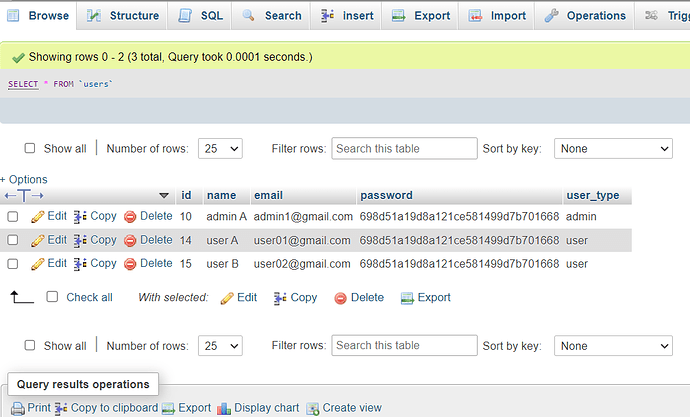Hi I am new to coding and a little stuck on where I have gone wrong with my code, as I keep receiving the following error when logging into my webpage:
Fatal error : Uncaught Error: mysqli object is already closed in C:\xampp\htdocs\flower\login.php:10 Stack trace: #0 C:\xampp\htdocs\flower\login.php(10): mysqli_real_escape_string(Object(mysqli), ‘[email protected]…’) #1 {main} thrown in C:\xampp\htdocs\flower\login.php on line 10
Any help would be very much appreciated.
Login Page
<?php
@include 'config.php';
session_start();
if(isset($_POST['submit'])){
$filter_email = filter_var($_POST['email'], FILTER_SANITIZE_STRING);
$email = mysqli_real_escape_string($conn, $filter_email);
$filter_pass = filter_var($_POST['pass'], FILTER_SANITIZE_STRING);
$pass = mysqli_real_escape_string($conn, md5($filter_pass));
$select_users = mysqli_query($conn, "SELECT * FROM `users` WHERE email = '$email' AND password = '$pass'") or die('query failed');
if(mysqli_num_rows($select_users) > 0){
$row = mysqli_fetch_assoc($select_users);
if($row['user_type'] == 'admin'){
$_SESSION['admin_name'] = $row['name'];
$_SESSION['admin_email'] = $row['email'];
$_SESSION['admin_id'] = $row['id'];
header('location:admin_page.php');
}elseif($row['user_type'] == 'user'){
$_SESSION['user_name'] = $row['name'];
$_SESSION['user_email'] = $row['email'];
$_SESSION['user_id'] = $row['id'];
header('location:home.php');
}else{
$message[] = 'no user found!';
}
}else{
$message[] = 'incorrect email or password!';
}
}
?>
<!DOCTYPE html>
<html lang="en">
<head>
<meta charset="UTF-8">
<meta http-equiv="X-UA-Compatible" content="IE=edge">
<meta name="viewport" content="width=device-width, initial-scale=1.0">
<title>login</title>
<!-- font awesome cdn link -->
<link rel="stylesheet" href="https://cdnjs.cloudflare.com/ajax/libs/font-awesome/6.0.0/css/all.min.css">
<!-- custom css file link -->
<link rel="stylesheet" href="css/style.css">
</head>
<body>
<?php
if(isset($message)){
foreach($message as $message){
echo '
<div class="message">
<span>'.$message.'</span>
<i class="fas fa-times" onclick="this.parentElement.remove();"></i>
</div>
';
}
}
?>
<section class="form-container">
<form action="" method="post">
<h3>login now</h3>
<input type="email" name="email" class="box" placeholder="enter your email" required>
<input type="password" name="pass" class="box" placeholder="enter your password" required>
<input type="submit" class="btn" name="submit" value="login now">
<p>don't have an account? <a href="register.php">register now</a></p>
</form>
</section>
</body>
</html>
Db connect
<?php
/* NOTE: this is a sample file and should be amended as required. */
$servername = "localhost";
$username = "kelly416";
$password = "Cocojackwillphoebetank5";
$dbname = "kelly416_shop_db";
// create the connection
$conn = new mysqli($servername, $username, $password, $dbname);
// if the connection fails send a message
if (!$conn) {
die("Connection failed. Notify Administrator.");
}
?>

